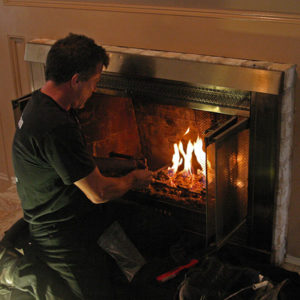Fireplaces and Indoor Air Quality
Fireside moments are among the high points of winter for many, though the issue of fireplaces and indoor air quality can become a concern. Certain problems arise with fireplaces fueled by wood and gas. More specifically, people can suffer health effects from inhaling pollutants caused by wood smoke and ventless gas fireplaces. More details follow about how fireplaces can have a negative impact on indoor air quality.
 Wood-Burning Fireplaces and Indoor Air Quality
Wood-Burning Fireplaces and Indoor Air Quality
Controlling the amount of wood smoke that enters your home is important because breathing it in is as unhealthy as breathing tobacco smoke. Fine and ultrafine particulate matter in wood smoke contains harmful substances that pollute indoor air.
The toxic contents in wood smoke include sulfur dioxide, formaldehyde, carbon monoxide, and such carcinogenic chemicals as dioxin and benzene. Nitrogen oxides, which can cause lung tissue scarring, are also in wood smoke. Fortunately, today’s wood heating appliances are far more efficient than in previous times, making them less harmful to indoor air quality.
The EPA began tightening emissions requirements on wood heaters on February 26, 1988. In spite of improvements in burning efficiency in various types of fireplaces and wood stoves, studies show that using wood-burning heat results in 26% higher fine particulate levels in homes.
Tips to Control the Amount of Indoor Pollution Caused by Wood Smoke
Because of the warmth and wonderful ambiance created by wood-burning fireplaces, their widespread popularity is perpetual. The EPA provides some helpful tips to minimize the negative impact on indoor air quality that wood-burning fireplaces can have, as follows:
- Do not burn wood that contains more than 25% moisture.
- Ensure that the chimney flue is warm before building up a large fire. This helps to avoid a poor draft that fails to pull combustion gases out of the home.
- Burn hot fires because doing so reduces wood smoke production.
- Make an adjustment to add more air into the burning chamber of your fireplace if you can see smoke coming out of your chimney.
- Use an air purifier in your home that will filter gases, odors, and chemicals as well as fine and ultrafine particles from your indoor air.
Indoor Air Quality and Ventless Fireplaces
Vent-free or ventless fireplaces use no ventilation system. As a result, combusted air is released directly into a home’s interior. Pollutants released into the living space by ventless fireplaces include nitrogen dioxide, carbon monoxide, and large amounts of humidity. All cause negative effects but it’s important to understand the dangers associated with carbon monoxide. Known as The Silent Killer, carbon monoxide has no odor, color, or taste. In addition, no symptoms are produced by carbon monoxide exposure until, oftentimes, a person is too badly affected to escape. Ventless fireplaces are banned in different local areas because of the serious effects they have on indoor air quality. Many options in solid fuel heating are highly efficient and cause minimal air pollution if any. For instance, pellet stoves and fireplaces create such complete combustion that they are deemed by the EPA to be smoke-free heating appliances. Fireplace inserts are also highly efficient and reduce total emissions, helping to protect indoor air quality.
 Contact Guardian About your Fireplace and Indoor Air Quality
Contact Guardian About your Fireplace and Indoor Air Quality
Guardian Chimney Sweep’s chimney technicians are qualified to professionally install fireplaces, fireplace inserts, wood-burning stoves, and pellet fireplaces. Ask about your fireplace and indoor air quality for expert recommendations. Contact Guardian if you live in the Houston TX or Conroe TX areas. Reach us by calling one of the numbers that follow or filling out our contact form today.
Toll-free: (888) 306-6069
Conroe: (936) 271-9781
Houston: (713) 401-2011

 Tap to Call Now
Tap to Call Now